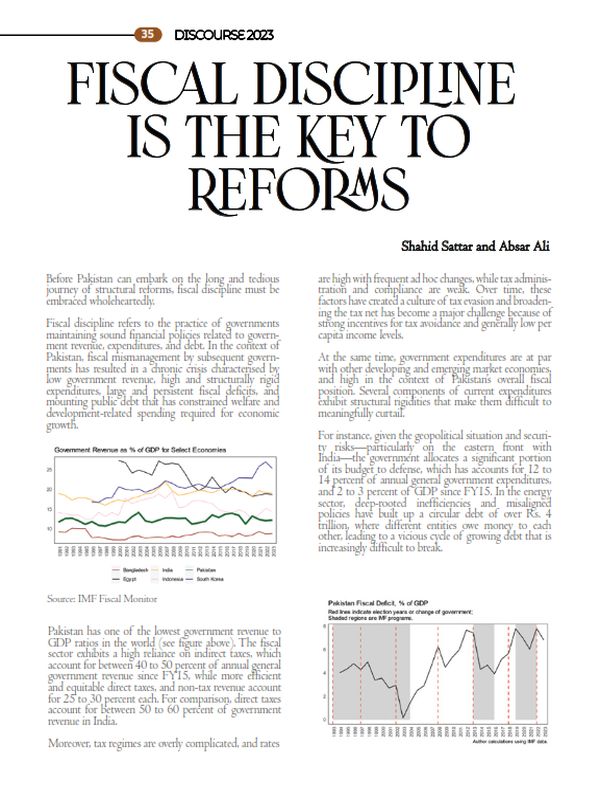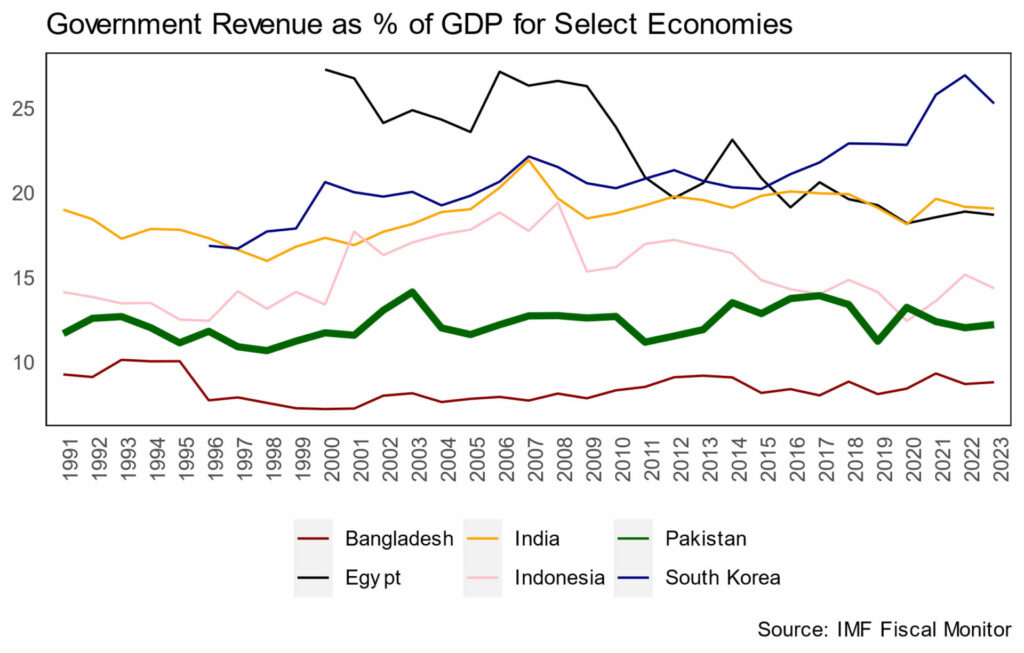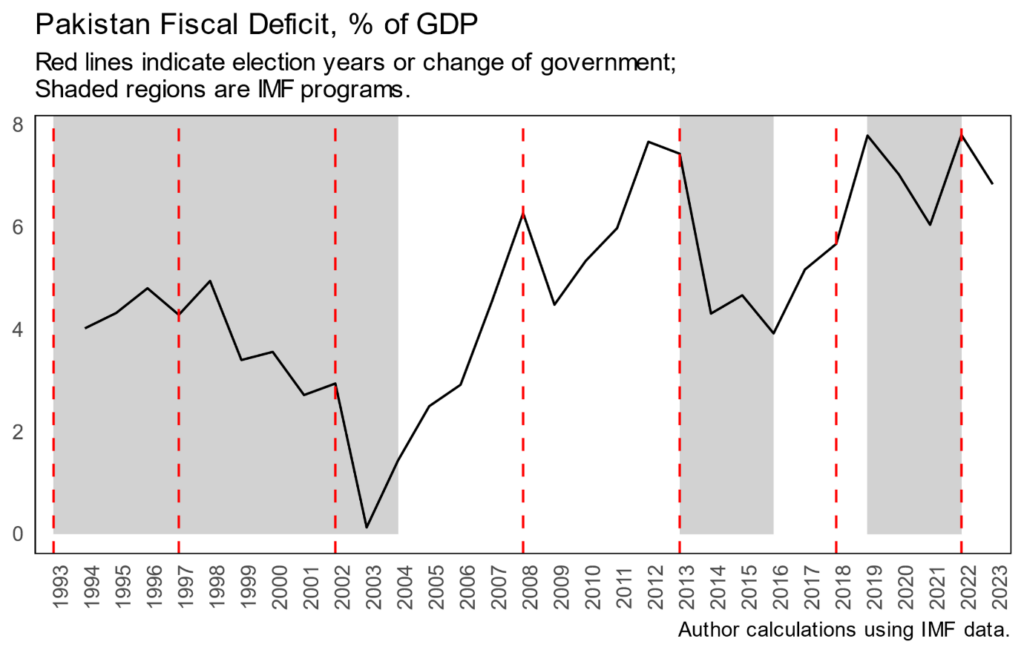
Pakistan Institute of Development Economics
- Home
Our Portals
MenuMenuMenuMenuMenuMenuMenu - ResearchMenuMenuMenuMenuMenuMenuMenu
- Discourse
- The PDR
- Our Researchers
- Academics
- Degree Verification
- Thesis Portal
- Our Portals
Fiscal Discipline is the Key to Reforms
Before Pakistan can embark on the long and tedious journey of structural reforms, fiscal discipline must be embraced wholeheartedly.
Fiscal discipline refers to the practice of governments maintaining sound financial policies related to government revenue, expenditures, and debt. In the context of Pakistan, fiscal mismanagement by subsequent governments has resulted in a chronic crisis characterised by low government revenue, high and structurally rigid expenditures, large and persistent fiscal deficits, and mounting public debt that has constrained welfare and development-related spending required for economic growth.
Pakistan has one of the lowest government revenue to GDP ratios in the world (see figure above). The fiscal sector exhibits a high reliance on indirect taxes, which account for between 40 to 50 percent of annual general government revenue since FY15, while more efficient and equitable direct taxes, and non-tax revenue account for 25 to 30 percent each. For comparison, direct taxes account for between 50 to 60 percent of government revenue in India.
Moreover, tax regimes are overly complicated, and rates are high with frequent ad hoc changes, while tax administration and compliance are weak. Over time, these factors have created a culture of tax evasion and broadening the tax net has become a major challenge because of strong incentives for tax avoidance and generally low per capita income levels.
At the same time, government expenditures are at par with other developing and emerging market economies, and high in the context of Pakistan’s overall fiscal position. Several components of current expenditures exhibit structural rigidities that make them difficult to meaningfully curtail.
For instance, given the geopolitical situation and security risks—particularly on the eastern front with India—the government allocates a significant portion of its budget to defense, which has accounts for 12 to 14 percent of annual general government expenditures, and 2 to 3 percent of GDP since FY15. In the energy sector, deep-rooted inefficiencies and misaligned policies have built up a circular debt of over Rs. 4 trillion, where different entities owe money to each other, leading to a vicious cycle of growing debt that is increasingly difficult to break.
Discretionary and politically motivated fiscal policies are a major reason for the dire state of the fiscal sector. Pakistan’s fiscal deficit exhibits a strong correlation with the political business cycle (see figure above). In the lead up to election years, governments—incentivized by electoral gains—increase spending on popular and often short-sighted initiatives and decrease revenue by providing tax breaks to politically favored segments. Low revenue collection and rigid current expenditures mean increased spending must be financed through borrowing. This causes the fiscal deficit to widen and increases debt servicing costs for future governments.
When new governments come in, they are faced with a difficult fiscal situation that requires them to curtail the deficit. Coupled with a vulnerable external sector and frequent external balance shocks, this often requires the help of international financial institutions like the IMF and other bilateral partners. The situation is brought under control through unpopular and ad hoc austerity measures that provide short term relief but create longer term distortions. Austerity measures are abandoned shortly thereafter, in the same ad hoc manner in which they were first introduced, as the next elections appear on the horizon. And the cycle repeats itself.
Frequent political turmoil and interruptions in the tenures of elected governments also hamper long-term fiscal planning and create an uncertain policy environment that deters foreign investment. These trends have culminated in a situation where the government sector is now consuming around 70 percent of domestic banking credit, with annual debt servicing costs for FY24 budgeted at Rs. 7.3 trillion—almost 40 percent of budgeted government revenue.
With a significant portion of its population living in poverty, Pakistan needs to spend on social welfare and development programs to achieve sustainable economic growth. However, fiscal constraints due to low revenue collection, high debt servicing costs and rigid current expenditures have limited the scope of spending on growth-oriented initiatives, which in turn has negative implications for future fiscal sector outlooks.
Moving forward, fiscal discipline must be embraced immediately to create room for growth-oriented spending. This requires setting time-bound targets to reign in fiscal deficits and public debt, and creating fiscal rules that place ceilings on fiscal deficits and public debt and rationalise government revenues and expenditures to ensure long-term and intergenerational debt sustainability.
Fiscal rules must be accompanied by a multipronged overhaul of the tax regime towards a growth-friendly structure, and a shift from reliance on indirect taxes and non-tax revenue towards direct taxes by reducing tax rates and expanding the tax base. Structural reforms in other sectors, such as pension and civil service reform, must be simultaneously pursued to address the structural rigidity of current expenditures.
This will achieve fiscal sector stabilisation, an imperative for long-term economic stability and prosperity, by stimulating economic growth rather than at the expense of an already highly burdened tax base, as is the status quo.
The authors are affiliated with the All Pakistan Textile Mills Association (APTMA).





